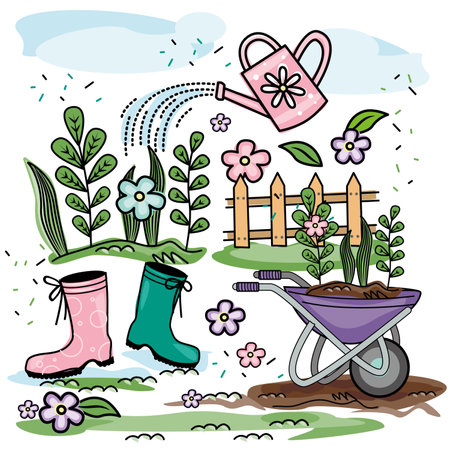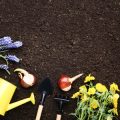1. Choose the Right Location
Picking the best spot for your compost pile is an important first step. You’ll want a place in your backyard that’s easy to access, drains well, and gets some sunlight during the day—but not full sun all day long. Partial sunlight helps keep the compost warm and active without drying it out too quickly.
Think about how close the location is to your kitchen or where you usually throw out food scraps. The closer it is, the easier it will be to keep up with composting daily. Also, make sure the spot is away from any buildings, fences, or water sources like wells or ponds. This helps prevent moisture problems and keeps pests at bay.
Ideal Compost Pile Location Checklist
| Consideration | Why It Matters |
|---|---|
| Good drainage | Prevents soggy compost and bad odors |
| Partial sunlight | Keeps compost warm without drying it out |
| Easy access | Makes daily composting more convenient |
| Away from structures | Reduces risk of pest issues or structural damage |
| Not near water sources | Prevents contamination of drinking water or natural habitats |
Once youve found a spot that checks all these boxes, youre ready to move on to setting up your compost pile structure and gathering materials.
2. Gather the Right Materials
To get your backyard compost pile off to a great start, its important to collect the right mix of materials. Composting works best when you have a balanced combination of “greens” and “browns.” These two types of materials provide the nutrients and structure needed for microbes to break everything down efficiently.
What Are Greens and Browns?
“Greens” are nitrogen-rich materials that help feed the microorganisms doing the composting work. “Browns” are carbon-rich and help provide structure, absorb moisture, and keep odors in check.
Common Examples:
| Greens (Nitrogen-Rich) | Browns (Carbon-Rich) |
|---|---|
| Fruit and vegetable scraps | Dry leaves |
| Coffee grounds | Cardboard (shredded) |
| Grass clippings | Newspaper (shredded) |
| Tea bags (non-plastic) | Sawdust (from untreated wood) |
| Plant trimmings | Paper towels (unbleached) |
The Ideal Ratio
A good rule of thumb is to aim for about 2 to 3 parts browns for every 1 part greens. This helps maintain the right balance of moisture and air in your pile, which encourages fast decomposition without bad smells.
Tips for Collecting Materials:
- Keep a small compost bin or container in your kitchen to collect fruit and veggie scraps throughout the week.
- If you mow your lawn, save some grass clippings as green material—but avoid using clippings treated with herbicides or pesticides.
- In the fall, collect dry leaves in bags so you’ll have browns available year-round.
- Shred cardboard boxes and newspaper before adding them to your pile for quicker breakdown.
Avoid These Items:
Some materials can attract pests or slow down the composting process. Don’t add meat, dairy, oily foods, pet waste, or glossy/coated paper products to your backyard compost pile.
By gathering a healthy mix of greens and browns, you’ll create an environment where beneficial microbes can thrive—turning your kitchen and yard waste into rich, crumbly compost that’s perfect for your garden.

3. Build or Set Up Your Compost Bin
Now that youve picked the perfect spot for your compost pile, its time to decide how you want to contain it. There are several options, and the best one depends on your space, budget, and how much effort youre willing to put into turning the compost.
Choose the Right Type of Compost Container
You can go with a traditional open pile, build your own bin from simple materials, or buy a ready-made tumbler. Heres a quick comparison to help you decide:
| Type | Pros | Cons |
|---|---|---|
| Open Pile | Easy and free to start; good for large yards | Less tidy; may attract pests if not managed well |
| Compost Bin (DIY or Store-Bought) | Keeps pile contained; reduces mess; better pest control | Might require building or upfront cost |
| Tumbler | Easy to turn; faster composting process; pest-proof | More expensive; limited capacity |
DIY Bin Options
If you’re into DIY projects, here are some easy ways to build your own compost bin using common materials:
- Wooden Pallets: Stand three pallets upright in a U-shape and secure them together with nails or zip ties. Add a fourth pallet as a front gate if desired.
- Wire Mesh: Form a circular bin using chicken wire or hardware cloth. Use stakes to hold it in place.
- Plastic Storage Bins: Drill holes in the sides and bottom of a heavy-duty plastic storage tote. This is great for small spaces like patios or balconies.
Tips for Setting Up Your Bin
- Aim for Good Airflow: Make sure your bin allows air to circulate through the pile.
- No Bottom Needed: If placing directly on soil, skip the bottom so worms and microbes can get in.
- Add a Lid: If youre concerned about rain or critters, add a cover or lid that still allows some airflow.
The goal is to create a structure that keeps your compost neat while letting nature do its work. Choose what fits your lifestyle and yard best—there’s no one-size-fits-all solution!
4. Layer and Maintain Your Compost Pile
To keep your compost pile healthy and breaking down efficiently, it’s important to build it in layers and give it the care it needs over time. Think of it like making a lasagna—alternating layers help everything mix well and decompose properly.
Alternate Between Green and Brown Materials
A good compost pile needs both “greens” (wet, nitrogen-rich materials) and “browns” (dry, carbon-rich materials). Alternating these layers helps create a balanced environment for microbes to do their job. Heres a quick guide:
| Greens (Nitrogen) | Browns (Carbon) |
|---|---|
| Fruit & veggie scraps | Dried leaves |
| Coffee grounds | Shredded newspaper |
| Grass clippings | Cardboard (non-glossy) |
| Tea bags (no staples) | Sawdust (from untreated wood) |
Aim for roughly 2–3 parts brown to 1 part green. Too many greens can make your pile smelly; too many browns can slow things down.
Keep It Moist—but Not Soaked
Your compost should feel like a wrung-out sponge: moist but not dripping wet. If it gets too dry, sprinkle some water on it. If its too wet, add more browns like shredded paper or dry leaves to soak up the excess moisture.
Turn the Pile Regularly
Aerating your pile is key to speeding up decomposition. Use a pitchfork or shovel to turn your compost every week or two. This adds oxygen, which helps break materials down faster and keeps bad smells away.
Troubleshooting Tips
- If your compost smells sour or rotten, add more browns and turn it more often.
- If its not breaking down quickly, check moisture levels and make sure youre turning it enough.
- If pests show up, avoid adding meat, dairy, or oily foods—and cover food scraps with browns.
With the right layering, moisture, and regular turning, your backyard compost pile will become rich, dark compost ready to use in your garden in just a few months.
5. Know What to Compost and What to Avoid
Adding the right materials to your compost pile is key to creating rich, healthy compost and avoiding common problems like bad smells or attracting pests. The general rule of thumb is to stick with plant-based, biodegradable items and stay away from anything that could rot too quickly or carry harmful bacteria.
What You Can Compost
These items are safe and beneficial for your backyard compost pile:
| Category | Examples |
|---|---|
| Fruit & Vegetable Scraps | Apple cores, banana peels, carrot tops, lettuce leaves |
| Coffee & Tea Grounds | Used coffee grounds, paper tea bags (without staples) |
| Yard Waste | Grass clippings, dry leaves, small branches, plant trimmings |
| Paper Products | Shredded newspaper, cardboard, paper towels (unbleached and clean) |
| Eggshells | Crushed eggshells (rinse before adding) |
What You Should Avoid
Certain materials can cause issues in your compost pile by attracting animals, creating foul odors, or introducing harmful pathogens. Keep these out:
| Avoid These Items | Why Theyre a Problem |
|---|---|
| Meat & Bones | Attract pests like raccoons and rodents; smell bad as they decompose |
| Dairy Products | Create odor and attract unwanted wildlife |
| Oily Foods & Grease | Slow down decomposition and smell unpleasant |
| Pet Waste (Dog/Cat) | Can carry parasites and bacteria harmful to humans |
| Treated Wood or Glossy Paper | May contain chemicals that are toxic to plants and soil life |
Quick Tips for Success
- Chop it up: Smaller pieces break down faster—cut large scraps into smaller chunks.
- Aim for balance: Try to keep a good mix of “greens” (like food scraps) and “browns” (like dry leaves or cardboard).
- Avoid liquids: Don’t pour milk, oil, or juice into your compost—it can cause sogginess and odor.
- No synthetic stuff: Plastics, metals, and synthetic fabrics should never go in your compost bin.
Keeping these guidelines in mind will help you build a compost pile that’s both effective and low-maintenance. Stick with natural, plant-based materials and you’ll be on your way to creating nutrient-rich soil for your garden.
6. Harvest and Use Your Compost
After patiently tending to your compost pile, you’ll start to notice big changes. In a few months to a year—depending on the materials used, weather, and how often you turn the pile—your compost will be ready to use. It should look dark, feel crumbly, and smell like rich earth.
How to Tell If Your Compost Is Ready
Here are a few signs that your compost is fully decomposed and good to go:
| Signs of Finished Compost | Description |
|---|---|
| Color | Dark brown or black |
| Texture | Crumbly, soil-like consistency |
| Scent | Pleasant, earthy smell (not sour or rotten) |
| No Visible Scraps | You shouldn’t see recognizable food or yard waste |
How to Harvest Your Compost
If youre using a bin or pile system, scoop out the finished compost from the bottom or center of the pile. Any unfinished bits can be returned to the top of the pile for further breakdown.
Helpful Tip:
A simple wire mesh screen can help sift out larger pieces that need more time to decompose.
Ways to Use Your Finished Compost
Your homemade compost is full of nutrients and beneficial microbes. Here’s how you can put it to work in your yard:
- Enrich Garden Soil: Mix compost into vegetable beds or flower gardens before planting.
- Lawn Top-Dressing: Spread a thin layer over your lawn to improve soil health and support grass growth.
- Potted Plants: Use as a natural fertilizer by mixing into potting soil or sprinkling on top of indoor and outdoor containers.
A Quick Guide to Using Compost
| Use | How Much to Apply |
|---|---|
| Garden Beds | Add 1–2 inches and mix into the top 6 inches of soil |
| Lawn Top-Dress | Sift 1/4 inch across lawn surface once or twice a year |
| Potted Plants | Add up to 20% compost mixed with potting soil |
Your finished compost is one of the best gifts you can give your garden—it improves soil structure, retains moisture, and feeds your plants naturally without synthetic chemicals.


